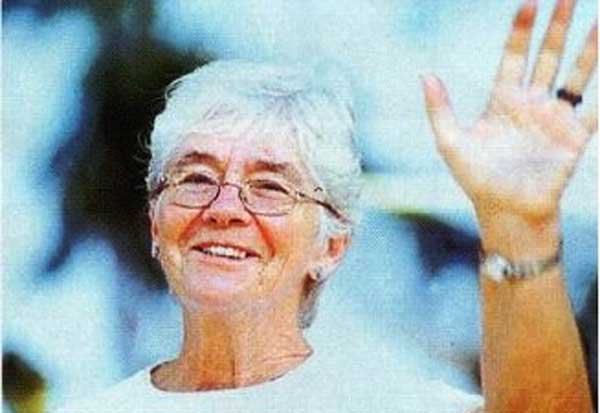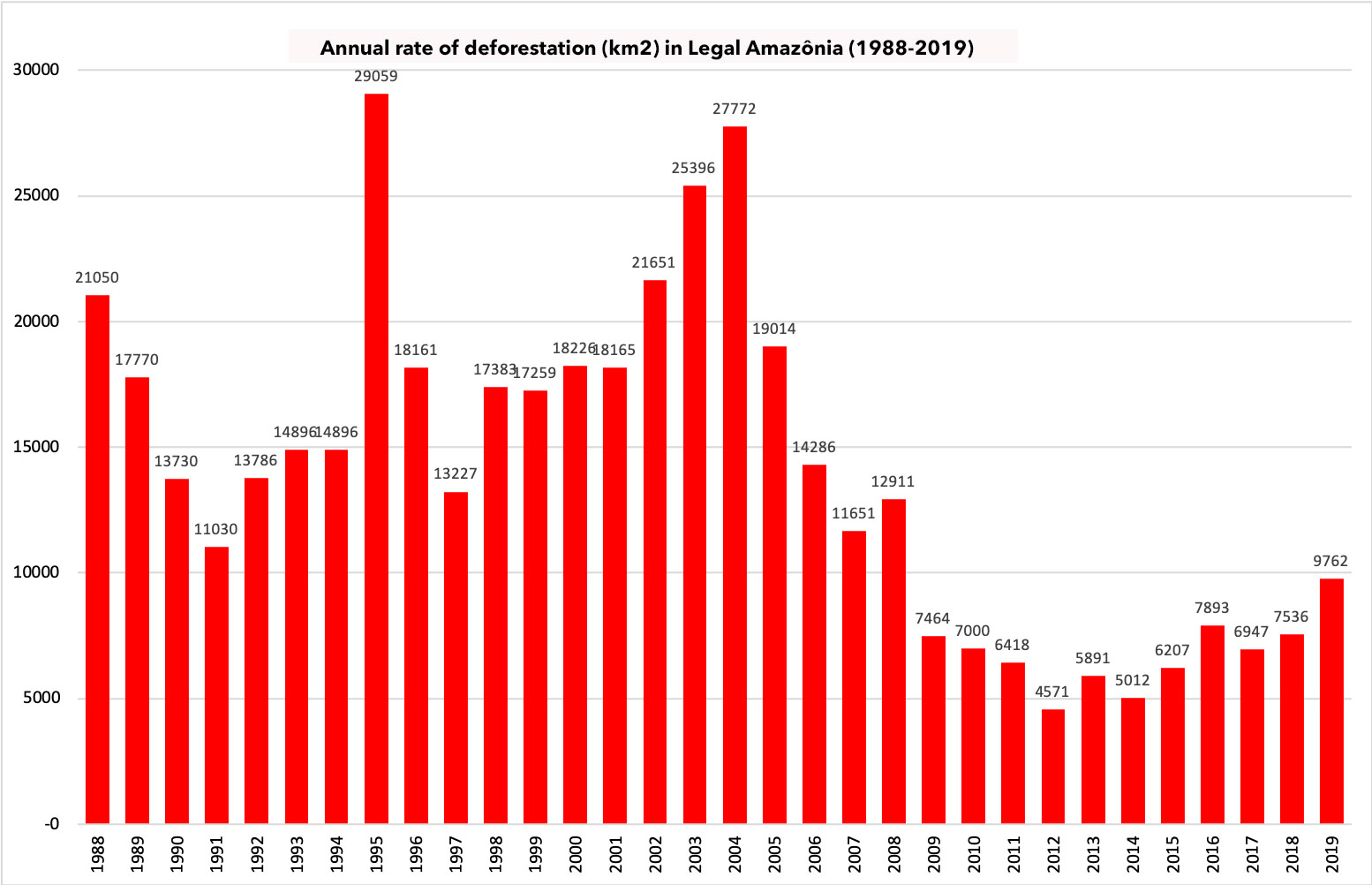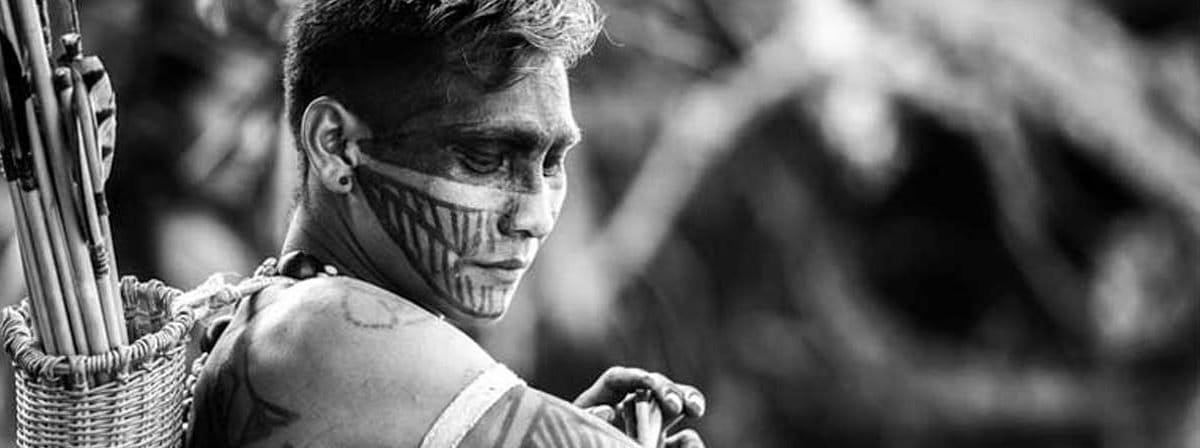- Brazil’s 21st century environmental record is most easily visualized via Amazon deforestation: poor regulation and lawlessness led to peak deforestation in 2004, with 27,772 square kilometers cleared. Better laws and enforcement, and a soy moratorium led to a dramatic decline to 4,571 square kilometers in 2012.
- Since then, first under Workers’ Party President Dilma Rousseff, then under Michel Temer, deforestation rates began to rise. The rate saw its biggest jump this year under President Jair Bolsonaro, with a loss of 9,762 square kilometers — the worst deforestation since 2008.
- From 2011-2016, the Amazon saw numerous hydroelectric project controversies, including the construction of the Belo Monte mega-dam, two huge hydroelectric projects on the Madeira River, plus multiple dams on the Teles Pires River. The Lava Jato corruption scandal and an economic downturn curbed dam building.
- Brazil’s ruralist agribusiness interests consolidated power, first under Temer, and more so under Bolsonaro, launching multiple attacks on indigenous and traditional land rights. Bolsonaro’s anti-environmental and anti-indigenous policies are a mark of his administration, a trend expected to continue in 2020.

In 2010 there were sound reasons for concern over the future of the Amazon — the earth’s greatest remaining forest, especially in Brazil. Huge hydroelectric projects were underway; agribusiness, particularly cattle ranching, was eating deeper into the Amazon; and genetically modified crops had been authorized, making it easier to grow soy in extreme tropical conditions, allowing for rapid expansion. Fewer protected areas were being created and recognition of indigenous land was happening at a snail’s pace.
Even so, there was room for hope. Environmentalists felt encouraged by an annual rate of deforestation in the Brazilian Amazon that had plunged to roughly a quarter of its earlier level — from 27,772 square kilometers (10,722 square miles) in 2004, down to 7,000 square kilometers (2,702 square miles) in 2010. Felling an area of tropical forest annually equivalent to eight times the size of New York City may have seemed horrifying to many then, but at least the trend was downwards. And the scale of deforestation didn’t seem to represent an imminent existential risk.
The decade ahead, some said, might even hold promise.…

Why deforestation fell in Amazônia, then rose
To understand what happened in Brazil over the last decade, it’s necessary to look back a little farther. In 2003, new Brazilian President Luiz Inácio da Silva, from the Workers’ Party (PT), appointed Marina Silva as environment minister. Silva, renowned as a committed environmentalist, was born into a family of Amazonian rubber tappers. Although the rate of deforestation took off during the first two years of Lula’s government, it fell during Silva’s tenure, until by 2012, well after she left office, it was down to 4,511 square kilometers (2,803 square miles) annually — just a sixth of the 2004 level.
Much of Silva’s success was due to her strategy of penning in development pressure by creating protected areas around big infrastructure projects and agribusiness expansion. Environmentalists drew up plans for vast new conservation units, but at first congress obstructed. The bancada ruralista agribusiness lobby — dominant in government today — was already powerful, forming a large bloc in the legislature, creating problems for Lula.
Then came the assassination of the American nun, Dorothy Stang in January 2005.
Sister Dorothy, as she was universally called, had campaigned fearlessly against illegal loggers, land grabbers and ranchers destroying the forest and threatening the livelihoods of poor rural populations in the Amazon basin. Her brutal assassination was a political embarrassment for the government. Responding to international outrage, Lula blew the dust off Silva’s plan to protect vast swathes of Amazon forest.

Just a few days after Sister Dorothy’s death, Lula, flanked by Silva, announced the creation of an 8.3 million-hectare (32,000 square-mile) “mosaic” of protected areas, spanning the southern Amazon basin, from Pará state in the east, to Mato Grosso state in the south, to Rondônia in the west — a conservation blockade against agribusiness intrusion.
The mosaic, along with other government measures, undoubtedly contributed to the decline in deforestation. But a more prosaic, reason — a pause in the world commodity boom in 2004 – also contributed. The underlying factor fueling Amazon deforestation had been soy production expansion via this process: land speculators cut down the forest, sold the land to ranchers, who after a few years, sold it to soy producers who created gigantic plantations in the Amazon. So a plunge in soy prices may have contributed to the deforestation decline.
Yet another factor was the availability of cleared forest: after the felling frenzy in 2004, ranching and agribusiness didn’t need more land.
This breathing space made it easier for environmental NGOs to influence international commodities companies to alter their behavior. First in 2006 came the Amazon soy moratorium, by which commodities companies agreed not to purchase soy cultivated on recently cleared Amazon forest lands, and then, in 2009, a beef moratorium. Although structural weaknesses allowed farmers to find ways of getting round them, the moratoriums reflected growing consumer concern over Amazon deforestation.

Lula and Dilma: dams and more dams
Then came major setbacks. During Lula’s second term (2007 to 2010), Brazil’s economy became increasingly dependent on commodity exports, strengthening ruralist power and emboldening them to openly clash with environmentalists. But politically savvy Lula found a way to mediate: the president would approve a big Amazon hydro-dam to serve the ruralists, then placate environmentalists by creating more protected areas.
His successor, Dilma Rousseff (2010-2016), handpicked by Lula, lacked political flair. She carried on with Lula’s policies but made little attempt to mollify environmentalists. She became widely disliked by conservationists, and also eventually by the ruralists, which would be her undoing.
In June 2011, Rousseff gave the go-ahead for the controversial Belo Monte mega-dam on the Xingu River — touted then as the third biggest in the world. Rhett Butler, Mongabay’s founder, wrote a heartfelt article at the time, in which he expressed shock at the government’s decision, noting that the dam would displace 16,000 people and flood 40,000 hectares (100,000 acres) of forest.
“When I speak to audiences,” he wrote, “I use Brazil as an example of a country that is leading the transition toward a more just and sustainable economy. With Belo Monte, I’m no longer certain Brazil is the model to emulate” Indeed, Belo Monte — with its deforestation, devastation of indigenous and traditional communities, and wrecking of natural habitats, along with corruption – was a bellwether of things to come.

By 2016, leading Brazilian commentators had concluded that Belo Monte was a bad project from “an economic, fiscal, environmental and human point of view.”
Over time, the scale of Belo Monte’s catastrophic harm became clear. Many tens of thousands of indigenous and traditional people were forced from their homes and lost their livelihoods. Fish kills caused Xingu River populations to decline heavily. By late 2019, it was clear that the future of the dam itself was compromised by recurrent droughts — droughts that have occurred periodically for decades and should have been predicted — while the dam’s construction was even found to be dangerously defective.
Belo Monte was no isolated case. In a raft of big development projects, Lula and Rousseff gave the go-ahead to two mega-dams on the Madeira River, near the frontier with Bolivia. Both caused serious environmental and social problems, and continue to do so. They also built four dams on the Teles Pires River, failing to consult indigenous people as required by international treaty and even permitting the dynamiting of rapids, sacred to the Munduruku people.

When prosecutors from the Federal Public Ministry (MPF), a group of independent public litigators, went to court on behalf of indigenous groups to halt the Teles Pires dams, they often won, but then the government used a highly questionable legal instrument, the so-called “Suspensão de Segurança,” to get its way. Through this instrument, a legacy from Brazil’s 1964-1988 military dictatorship, the government — then and now — can postpone the implementation of any lower court decision until the end of a lengthy legal process by simply declaring a threat to “national security.” In practice, this means the original ruling is overturned.
Still, the government and dam developers didn’t always win. The Munduruku and other indigenous groups, along with traditional communities fought back. In August 2016, after persistent indigenous pressure, the environmental agency, IBAMA, denied a licence for another gigantic dam planned for the Tapajós River — the 8,000 megawatt São Luiz de Tapajós. No subsequent government has attempted to reverse that decision.

Temer undermines socioenvironmental gains
It was the gigantic government-funded dam projects that ultimately helped bring about Rousseff’s and the Workers’ Party undoing, bringing the far right to power.
Lava Jato, Operation Car Wash, a massive corruption investigation, found that the PT had been running a gigantic payoff operation involving Petrobras, Brazil’s state-run oil company, along with Brazil’s gigantic construction companies. The scheme: construction firms, including Odebrecht, Andrade Gutierrez and others, offered massive political contributions to the Workers’ Party, and others, in trade for mega-dams and a variety of development contracts. It was Lava Jato public outcry against corruption that finally helped lead to the impeachment of Rousseff in August 2016 and her replacement by Michel Temer.
Under Temer, an unpopular president whose approval rating never rose above the single digits, was someone the ruralists were able to easily dominate. By mid-2017, they were largely calling the shots, with Temer requiring their support to prevent Congress from impeaching him for corruption connected to JBS, Brazil’s giant meatpacking firm.
The ruralists leveraged their power to boost agribusiness, and chip away at environmental advances, with a particular determination to undermine indigenous land rights. The ruralists had longed complained of Brazil’s indigenous peoples occupying 12 percent of Brazilian territory while making up only 0.5% of the population. Ignoring the key role that indigenous communities play in protecting forests, they asserted time and again that this was grossly unfair. But over time it became increasingly clear that what was driving the ruralists was desire for these lands.

So the first priority of ruralists under Temer was to stop the slow and meticulous indigenous reserve demarcation process, underway since the implementation of the progressive 1988 Constitution, by which indigenous groups gained formal recognition of the land they occupy.
The ruralistas’ strategy wasn’t to present bills to Congress where they still lacked the votes needed for passage, but to use indirect tactics, such as accepting a recommendation made by the Attorney General’s Office that federal government bodies should adopt new stringent criteria for recognizing indigenous lands, aimed at stalling the demarcation process.
Respected lawyer Dalmo de Abreu Dallari, said of the new demarcation criteria that it had as its objective the “extorting from indigenous communities their right to the land they have traditionally occupied.”
Temer did much else: he introduced an amnesty erasing up to $2.1 billion in unpaid environmental fines, especially for illegal deforestation. To howls of indignation from human rights activists, he issued a decree weakening the definition of slavery, excluding those working in degrading and inhumane conditions. But he didn’t always win. His attempt to open the gigantic and pristine 4.6 million hectare (17,800 square mile) RENCA preserve in the northern Amazon to Canadian and other transnational mining interests was defeated by a national and international public outcry.
Emboldened by their success, the ruralists stepped up violent attacks in remote areas. In 2017, Brazil became the most dangerous country in the world for social and environmental activists, with 57 assassinations as a result of land conflict.

Then came Bolsonaro
In October 2018 the ruralists solidified their power by supporting former army officer, Jair Bolsonaro who was elected President.
Now, the ruralists, in unprecedented fashion, operated the levers of government, controlling 44% of the Congress and represented by a president whose extreme policies even made some in agribusiness uncomfortable. Populist Bolsonaro is a climate change denier, is openly hostile toward indigenous peoples, even believes that landowners have the right to bear arms to defend themselves against people who reject their illicit land claims, and he looks back nostalgically at Brazil’s military dictatorship.
From his first day in office, Bolsonaro began slashing away at the web of laws, regulations and agencies meant to curb environmental harm caused by mining, agribusiness and big infrastructure projects.
The journalist Bernardo Mello Franco, who writes for Brazil’s influential O Globo newspaper, called Bolsonaro’s environment minister Ricardo Salles, himself under investigation for environmental crime, an “anti-minister, who is doing all he can to destroy what he should be protecting” and who is turning “his ministry into a playground for the ruralists.”
Even before Bolsonaro came to power, the authorities’ lack of concern for environmental safety was costing Brazil dear. In November 2015 a Vale Corporation tailings storage dam collapsed in Mariana in Minas Gerais state, killing 19 and polluting the Doce River for 440 miles. Then in January 2019, as Bolsonaro stepped into office, another Vale tailings dam disaster occurred in Brumadinho, also in Minas Gerais. It killed 249 people, leaving another 21 missing.

Under Bolsonaro deforestation is rising again, as illegal loggers and land grabbers take advantage of the permissive political climate. Altogether, 7,604 square kilometers (2,970 square miles) of rainforest were felled during the first nine months of this year, an 85 percent increase over the same period last year.
In August, images of raging Amazon fires were splashed across the front pages of the world press, particularly after Brazil’s largest city, São Paulo, went dark at midday as winds, carrying smoke from the fires, blocked out the sun. That one event could be considered symbolic of what may lay ahead for Brazil’s environment, the Amazon and its people.
Violence is surging, as lawless bands, emboldened by the ruralists and Bolsonaro’s incendiary rhetoric, kill social, political and environmental activists. Among many recent incidents, two Guajajara indigenous leaders were shot dead in early December, not far from where another Guajajara leader and “forest guardian” was killed a month earlier.

International reverberations
Ominously, what is happening in Brazil won’t likely stay there. Experts warn that the current deforestation will make it virtually impossible for Brazil, the world’s seventh largest emitter of greenhouse gases, to achieve the commitments it made under the 2015 Paris Agreement, and may possibly jeopardize the whole global accord.
Moreover, deforestation, combined with escalating climate change, is pushing the Amazon toward a rainforest-to-savanna “tipping point” which would result in massive tree death and a gush of sequestered carbon into the atmosphere at a time when the world can least afford it. Ironically, the mega-drought that could soon devastate Amazon forests would also empty Brazil’s aquifers and be catastrophic for agribusiness — and thus for the whole Brazilian economy.
Some of the world’s largest companies are getting worried and responding to Bolsonaro’s polices. In September 2019, some 230 global investors with $16.2 trillion in assets urged companies to eliminate Amazon deforestation from their supply chains. Then in December, 87 large UK companies, including Tesco and Sainsbury, signed a letter to Bolsonaro asking his government to stop Amazon deforestation for soy production.

International pressure seems likely to grow as the president turns increasingly belligerent and aggressive, but it will take more than urging to save the Amazon basin. Some activists think the only current hope for the rainforest may lie with an international boycott. Combined with the growing mobilization of social movements underway inside Brazil, such a boycott might cause the Bolsonaro government to rethink its policies in the years ahead.
Disturbingly, scientists can’t pinpoint an ecological tipping point until it is passed. But some warn that Amazon deforestation could be pushing things dangerously close to collapse. Assuring a positive future for Brazil and the world requires putting on the brakes before the precipice is reached.
Banner image caption: A Munduruku warrior. Photo by Mauricio Torres.
FEEDBACK: Use this form to send a message to the author of this post. If you want to post a public comment, you can do that at the bottom of the page.

